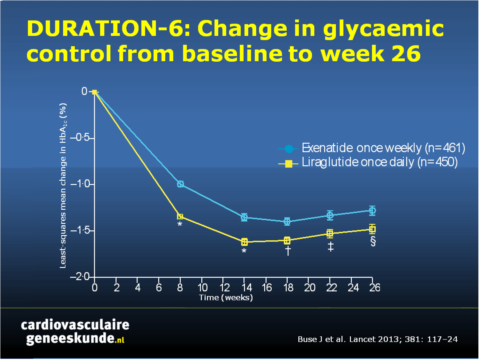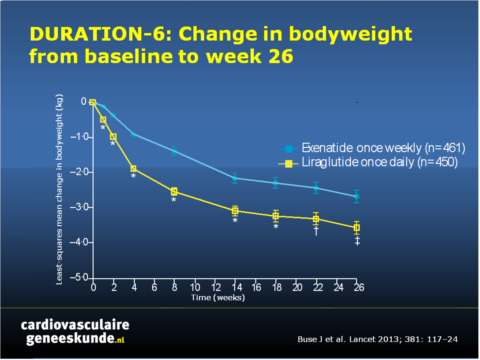Liraglutide versus exenatide bij type 2 diabetes
Literatuur - Buse JB, Nauck M, Forst T, et al. - Lancet. 2013;381:117-24.
Exenatide once weekly versus liraglutide once daily in patients with type 2 diabetes (DURATION-6): a randomised, open-label study.
Buse JB, Nauck M, Forst T, et al.
Lancet. 2013;381:117-24. doi: 10.1016/S0140-6736(12)61267-7.
Achtergrond
GLP-1 receptor agonisten zijn een vrij nieuwe klasse van antihyperglycemische middelen voor patiënten met type 2 diabetes [1] en zijn goedgekeurd voor gebruik in aanvulling op eerstelijns middelen zoals metformine. Exenatide en liraglutide zijn voorbeelden van GLP-1-agonisten en zijn goedgekeurd voor een keer per week (exenatide) of eenmaal daags (liraglutide) gebruik bij patiënten met type 2 diabetes [2 - 11]. Het gebruik van deze nieuwe middelen is op dit moment beperkt, vooral vanwege de kosten.In DURATION-6 werden 911 patiënten met type 2 diabetes op 105 locaties in 19 landen gerandomiseerd in een open-label parallelle groepen design naar eenmaal daagse injecties van liraglutide (1,8 mg, n = 450) of eenmaal per week exenatide (2 mg , n = 461). De resultaten werden geanalyseerd op een intention-to-treat basis. De deelnemers hadden al aanpassingen van de levensstijl ondergaan en namen maximale of bijna-maximale doseringen van orale antihyperglycemische middelen, maar hadden nog steeds suboptimale glykemische controle. Het primaire eindpunt was de verandering in HbA1c vanaf baseline tot zes maanden.
Belangrijkste resultaten
- Beide GLP-1-agonisten gaven verbetering van de glykemische controle, met sterkere verlagingen met liraglutide: -1,48% in vergelijking met -1,28% voor de exenatide groep (fig.1).
- Het totale verschil in HbA1c tussen de twee was klein (0,21%)
- Beide behandelingen waren geassocieerd met progressieve afname in lichaamsgewicht (fig. 2). Patiënten die liraglutide kregen, verloren meer gewicht dan degenen die exenatide kregen, ongeacht BMI.
- Gastro-intestinale bijwerkingen -misselijkheid, braken en diarree- kwamen twee keer zo vaak voor met liraglutide.
Conclusie
Behandeling met exenatide eenmaal per week of liraglutide eenmaal daags gaf een effectieve glucose verlaging in combinatie met gewichtsverlies en minimale hypoglykemische episodes bij patiënten met type 2 diabetes. De verschillen tussen de klinische werkzaamheid van liraglutide eenmaal daags en exenatide eenmaal per week bij de geteste doseringen, alsmede de frequentie en wijze van injectie, kunnen worden gebruikt door artsen in de besluitvorming over behandeling van patiënten met type 2 diabetes onvoldoende gecontroleerd door orale antidiabetica.Redactioneel commentaar [12]
"Er zijn enkele punten van kritiek op de studieduur en dosering van liraglutide, naast andere dingen. Nochtans was de studie goed uitgevoerd, en ook al is het primaire eindpunt niet behaald, kunnen de resultaten clinici helpen om passende behandelingskeuzes te maken op basis van de relatieve werkzaamheid en het risico op bijwerkingen op korte termijn. "Download CVG Duration 2013.pptx


Figuur 1: Verandering in glycemische controle van baseline tot week 26.
p waarden van behandelingsverschil weergegeven voor weken 8, 14, 18, 22 en 26. 95% CI voor behandelingsverschillen waren: week 8 (0.27-0.43), week 14 (0.16-0.37), week 18 (0.09-0.31), week 22 (0.08 -0.32), en week 26 (0.08-0.33). HbA1c = geglycosyleerd hemoglobine. * p <0.0001. † p = 0.0005. ‡ p = 0.0012. § p = 0.0018
Figuur 2: Verandering in lichaamsgewicht ten opzichte van baseline tot week 26
p waarden voor behandeling verschillen weergegeven voor weken 1, 2, 4, 8, 14, 18, 22 en 26. 95% CI voor de behandeling verschillen waren: week 1 (0.24-0.50), week 2 (0.44-0.76), week 4 (0.77-1.20), week 8 (0.88 -1.47), week 14 (0.54 – 1.31), week 18 (0.52 tot 1.39), week 22 (0.42-1.36), en week 26 (0.39 – 1.40). * p <0.0001. † p = 0.0002. ‡ p = 0.0005.
Referenties
1. Drucker DJ, Nauck MA. The incretin system: glucagon-like peptide-1 receptor agonists and dipeptidyl peptidase-4 inhibitors in type 2 diabetes. Lancet 2006; 368: 1696–705.2. Bergenstal RM, Wysham C, MacConell L, et al. Efficacy and safety of exenatide once weekly versus sitagliptin or pioglitazone as an adjunct to metformin for treatment of type 2 diabetes (DURATION-2): a randomised trial. Lancet 2010; 376: 431–39.
3. Diamant M, Van Gaal L, Stranks S, et al. Once weekly exenatide compared with insulin glargine titrated to target in patients with type 2 diabetes (DURATION-3): an open-label randomised trial. Lancet 2010; 375: 2234–43.
4. Drucker DJ, Buse JB, Taylor K, et al. Exenatide once weekly versus twice daily for the treatment of type 2 diabetes: a randomised, open-label, non-inferiority study. Lancet 2008; 372: 1240–50.
5. Blevins T, Pullman J, Malloy J, et al. DURATION-5: Exenatide once weekly resulted in greater improvements in glycemic control compared with exenatide twice daily in patients with type 2 diabetes. J Clin Endocrinol Metab 2011; 96: 1301–10.
6. Zinman B, Gerich J, Buse JB, et al. Efficacy and safety of the human GLP-1 analog liraglutide in combination with metformin and TZD in patients with type 2 diabetes mellitus (LEAD-4 Met+TZD). Diabetes Care 2009; 32: 1224–30.
7. Russell-Jones D, Vaag A, Schmitz O, et al. Liraglutide vs insulin glargine and placebo in combination with metformin and sulfonylurea therapy in type 2 diabetes mellitus (LEAD-5 met+SU): a randomised controlled trial. Diabetologia 2009; 52: 2046–55.
8. Nauck M, Frid A, Hermansen K, et al. Eff cacy and safety comparison of liraglutide, glimepiride, and placebo, all in combination with metformin, in type 2 diabetes: the LEAD (liraglutide effect and action in diabetes)-2 study. Diabetes Care 2009; 32: 84–90.
9. Marre M, Shaw J, Brandle M, et al. Liraglutide, a once-daily human GLP-1 analogue, added to a sulphonylurea over 26 weeks produces greater improvements in glycaemic and weight control compared with adding rosiglitazone or placebo in subjects with type 2 diabetes (LEAD-1 SU). Diabet Med 2009; 26: 268–78.
10. Buse JB, Rosenstock J, Sesti G, et al. Liraglutide once a day versus exenatide twice a day for type 2 diabetes: a 26-week randomised, parallel-group, multinational, open-label trial (LEAD-6). Lancet 2009; 374: 39–47.
11. Garber A, Henry R, Ratner R, et al. Liraglutide versus glimepiride monotherapy for type 2 diabetes (LEAD-3 Mono): a randomised, 52-week, phase III, double-blind, parallel-treatment trial. Lancet 2009; 373: 473–81.
12. Thethi T and Fonseca V. Comparing diabetes drugs—helping clinical decisions? Lancet 2013; 381:93-94
Abstract
Background:
Glucagon-like peptide-1 receptor agonists exenatide and liraglutide have been shown to improve glycaemic control and reduce bodyweight in patients with type 2 diabetes. We compared the efficacy and safety of exenatide once weekly with liraglutide once daily in patients with type 2 diabetes.
Methods:
We did a 26 week, open-label, randomised, parallel-group study at 105 sites in 19 countries between Jan 11, 2010, and Jan 17, 2011. Patients aged 18 years or older with type 2 diabetes treated with lifestyle modification and oral antihyperglycaemic drugs were randomly assigned (1:1), via a computer-generated randomisation sequence with a voice response system, to receive injections of once-daily liraglutide (1•8 mg) or once-weekly exenatide (2 mg). Participants and investigators were not masked to treatment assignment. The primary endpoint was change in glycated haemoglobin (HbA(1c)) from baseline to week 26. Analysis was by intention to treat. This trial is registered with ClinicalTrials.gov, number NCT01029886.
Findings:
Of 912 randomised patients, 911 were included in the intention-to-treat analysis (450 liraglutide, 461 exenatide). The least-squares mean change in HbA(1c) was greater in patients in the liraglutide group (-1•48%, SE 0•05; n=386) than in those in the exenatide group (-1•28%, 0•05; 390) with the treatment difference (0•21%, 95% CI 0•08-0•33) not meeting predefined non-inferiority criteria (upper limit of CI <0•25%). The most common adverse events were nausea (93 [21%] in the liraglutide group vs 43 [9%] in the exenatide group), diarrhoea (59 [13%] vs 28 [6%]), and vomiting 48 [11%] vs 17 [4%]), which occurred less frequently in the exenatide group and with decreasing incidence over time in both groups. 24 (5%) patients allocated to liraglutide and 12 (3%) allocated to exenatide discontinued participation because of adverse events.
Interpretation:
Both once daily liraglutide and once weekly exenatide led to improvements in glycaemic control, with greater reductions noted with liraglutide. These findings, plus differences in injection frequency and tolerability, could inform therapeutic decisions for treatment of patients with type 2 diabetes.

Deel deze pagina met collega's en vrienden: